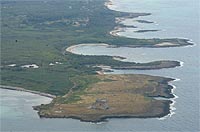
NATURE
- Parks and Reserves
NATURAL RESERVE
OF TORRE GUACETO
 The
protected park of Torre Guaceto, situated about 18 km
north of Brindisi, is an important area of naturalistic
interest; it was born to the end of seventies and nowadays
is managed by the Consortium formed from the town councils
of Brindisi and Carovigno and from WWF Italia. The
protected park of Torre Guaceto, situated about 18 km
north of Brindisi, is an important area of naturalistic
interest; it was born to the end of seventies and nowadays
is managed by the Consortium formed from the town councils
of Brindisi and Carovigno and from WWF Italia.
During the summer the Consortium organizes excursions
like ciclotrekking (by bicycle), walks and seawatching
(more info +39 0831.989885).
The entire area is rich of a diversity of habitats and
landscapes; the ecosystems includes Marine Protected
Area, approximately 730 hectares of sea facing the
coast, and about 210 hectares of the Natural State
Reserve; it has international relevance according
to the Ramsar agreement guidelines.
The area is dominated by the ancient Aragones tower
built in 1531, nowadays WWF Center of Environmental
Education.
(Click on the map for enlarge)
Marine Protected
Area
 It
is about 730 hectares of sea with five little islands,
which still carry traces of the frequentation of anthropic
cultures by archaeological finds (from the prehistory
until to the late Middle Age). It
is about 730 hectares of sea with five little islands,
which still carry traces of the frequentation of anthropic
cultures by archaeological finds (from the prehistory
until to the late Middle Age).
The marine habitat is extremely rich of animal and vegetable
species; the seabed represents an important wealth for
the sea of Salento territory. In the area close to the
coast there are few coral reefs and the Oceanic Posidonia
sea grass, offering perfect conditions enabling a wide
variety of marine species to inhabit this area of sea.
The presence of the "Caretta Caretta" turtles
is quite relevant, as far as the dolphins.
Here is possible to practice "sea-watching",
swimming on the sea surface, with the park's guide,
to observe the flora and marine fauna.
Natural State
Reserve
 It
include the humid zone, Maquis and the beaches with
their old-ages sandy dunes. It
include the humid zone, Maquis and the beaches with
their old-ages sandy dunes.
The Maquis is populated by some mammals like the badger,
the weasel, the fox, some little rodents, the reptiles
like green lizard and some endemic species of lizards.
The shrubs host nests of Blackcap, Goldfinch, Little-eye,
Serin, Nightingale, Cinciallegra, Robin and Blackbird.
The flora is characterized by the aromatic plants of
Myrtle, the Evergreen Mastic, the Aleppo Pine tree,
the Evergreen Oak, the Alaterno, acacia, brooms and
secular plants of juniper that produce berries called
"Cuddles".
The cane-brake area is characterized by "phragmites"
and some plants of "typha", biomarker of the
presence of fresh water (Guaceto means "fresh water",
from the arab word "gaw-sit"). Here there
is a mix of subsoil's fresh water and marine water that
form a brackish marsh.
The zone is a natural destination of numerous migratory
birds, as the Hawks and the mallards, and residence
of several amphibians and invertebrates.
On the beautiful beaches,
where the wild rabbits live, one can find the marine
species of radish, narcissus, lily, the convolvulus,
and other species which form the naturalistic landscape
of the whole zone.
Here the old-age sandy dunes strengthened by the plants'
root, offer an enchanting landscape that may remind
the desert's dunes.
The best period for
visiting the park is from March to November, when it's
very interesting to admire the intense colours of the
flowers and of the small plants, and observe the migratory
birds and wildlife.
The park is always
open, for booking a visits one can call the Visitor
Centre of the Consortium (+39 0831 9898859).
«
Back
|

